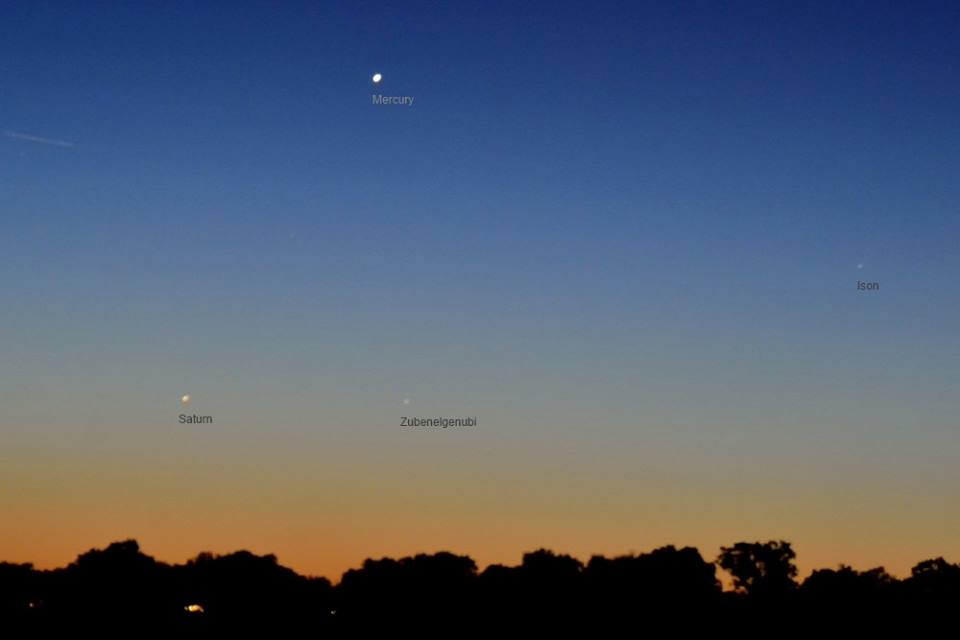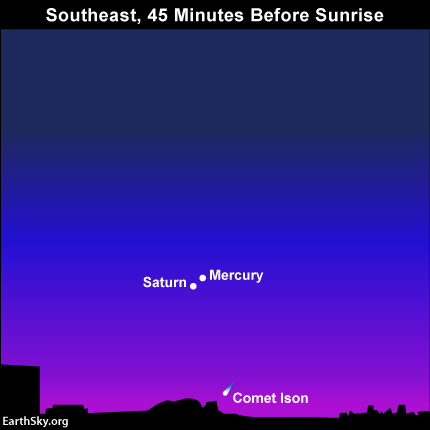View larger. | Gerald Rhemann in Namibia in SW Africa captured this photo of Comet ISON on November 21, 2013, one week before its encounter with the sun. Visit Gerald’s website Sky Vistas. Used with permission.
Comet ISON is now inside the orbit of Mercury. It’s on the last leg of its journey sunward, a journey that began at least a million years ago.
At least a million Earth-years ago, the icy chunk we know as Comet C/2012 S1 ISON began its journey sunward from the Oort Cloud surrounding our solar system. Comet ISON will reach its perihelion – closest point to the sun – on Thursday, November 28, 2013. One week beforehand, on November 21, Gerald Rhemann in Namibia in southwestern Africa captured this beautiful photo of ISON, now in the last leg of its long journey. Details of the photo are:Date: 21.11.2013 UT 02h49mThank you, Gerald!
Location: Farm Tivoli, Namibia/SW Africa
Telescope: ASA 12″ N f 3.8 Astrograph
Camera: FLI ML 8300
Mount: ASA DDM85
Exposure time: LRGB 3/2/2/2 min.
ISON is considered a sun-diving comet. At its closest, it will skim very close to the sun, just 724,000 miles (1,165,000 km) above the sun’s surface.
If Comet ISON is able to sweep past the sun and head back toward the outer solar system again without breaking up, it may become visible to the eye alone in the predawn sky in early December.

View larger. | Our friend Annie Lewis in Madrid, Spain caught Comet ISON on Saturday morning, November 23, near the planets Mercury and Saturn. Thank you, Annie! Notice that the comet is very low in eastern predawn twilight. Annie’s camera caught it, but your eye may not.

On Sunday morning, November 24, the comet will still be near Saturn and Mercury, which, by the way, are poised for a close conjunction on November 25 and 26. Will you be able to see the comet? You’ll need a pristine sky – clear all the way to the horizon – and binoculars to scan near the planets.

Here is Comet ISON Monday morning, November 25. See how it’s even farther below Mercury and Saturn than on Sunday? It’s heading toward the sun! It’ll come closest to the sun on November 28. If it survives, it might then become a bright object in our predawn sky.

If Comet ISON survives its close sweep past the sun, it should emerge back into our eastern predawn sky in early December. Fingers crossed!
Close pairing of Saturn and Mercury dawn November 25 and 26
Sursa:
http://earthsky.org/todays-image/comet-ison-nears-the-sun
=========================================
=====================================================
===============================================================
MATERIALE VIDEO:
========================
========================
================================================
========================
=================================================



Cometa secolului ar putea oferi un spectacol fascinant.
RăspundețiȘtergere===============
Un eveniment astronomic extrem de rar va avea loc pe 3 decembrie. Milioane de oameni din emisfera nordică vor putea să vadă cu ochiul liber coada strălucitoare a cometei ISON.
Pentru oamenii de ştiinţă prezintă cel mai mare interes trecerea cometei prin coroana solară, fenomen care se va produce pe 28 noiembrie.
La un moment, ISON se va afla în punctul cel mai apropiat de Soare, la 1.800.000 de kilometri, iar temperatura va depăşi 2.000 de grade Celsius.
Impactul cu Soarele ar putea să ducă la distrugerea cometei. Daccă va supravieţui, atunci ea va fi vizibilă pe cer toată luna decembrie.
http://romanian.ruvr.ru/news/2013_11_24/Cometa-secolului-ar-putea-oferi-un-spectacol-fascinant-4029/?bottom=news
Începând de luni comenta ISON nu va mai putea fi observată, o vreme, deoarece este prea aproape de Soare.
RăspundețiȘtergere==================
Este doar o situație provizorie, iar cometa va redeveni vizibilă în jurul zilei de 5 decembrie, conform simulatorului Comet ISON flyby simulation, pe care vi-l recomandam într-o postare anterioară. În acest interval de timp, mai exact pe 28 noiembrie, cometa va trece pe la periheliu, când cometa se va afla la o distanță de Soare de numai 1.860.000 km. Să sperăm că în acest interval de timp nucleul cometei nu se va fragmenta și că în luna decembrie vom avea parte de spectacolul pe care îl așteptăm cu nerăbdare, scrie stiintasitehnica.com.
Chiar dacă observatorii de pe Terra nu vor mai putea vedea cometa preț de câteva zile, sondele aflate în spațiu vor continua să o monitorizeze. Astfel, pe 27 noiembrie sonda SOHO (Solar and Heliospheric Observatory) va începe monitorizarea cometei. SDO (Solar Dynamics Observatory) și sonda Hinode vor transmite imagini din perioada în care cometa se va afla la periheliu. Astfel vom afla din timp ce se întâmplă cu nucleul cometei.
Sursa REALITATEA.NET: http://www.realitatea.net/daca-va-supravie-ui-apropierii-de-soare-cometa-ison-va-oferi-un-spectacol-astronomic-uimitor_1324849.html#ixzz2lhwkzUur
Follow us: @realitatea on Twitter
Pe 28 noiembrie, ISON aşa numita „cometă a secolului” va trece la o distanţă minimă de Soare. De o săptămână, oamenii de ştiinţă urmăresc cu atenţie această cometă şi o vor monitoriza şi în continuare, dacă ea nu va fi distrusă de căldura Soarelui. Oamenii de ştiinţă încă nu ştiu care va fi soarta cometei în cazul unei treceri reuşite pe lângă Soare.
RăspundețiȘtergerePotrivit astronomilor, în ultimele ore cometa şi-a pierdut considerabil luminozitatea. Acum ea corespunde stelei Sirius, care este cea mai strălucitoare de pe cer.
Oamenii de ştiinţă consideră că şansele cometei de a rezista „loviturii solare” sunt de 30-40%.
Sursa: http://romanian.ruvr.ru/news/2013_11_28/Cometa-ISON-se-poate-ciocni-astazi-cu-Soarele-6082/